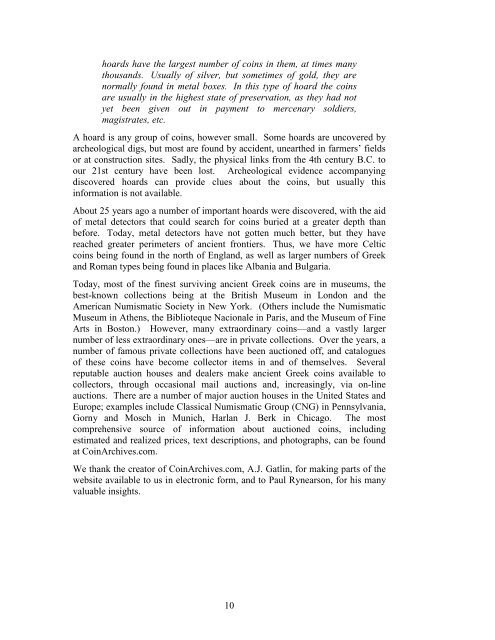Background on Greek coins.pdf - RebelText
Background on Greek coins.pdf - RebelText
Background on Greek coins.pdf - RebelText
Create successful ePaper yourself
Turn your PDF publications into a flip-book with our unique Google optimized e-Paper software.
hoards have the largest number of <strong>coins</strong> in them, at times many<br />
thousands. Usually of silver, but sometimes of gold, they are<br />
normally found in metal boxes. In this type of hoard the <strong>coins</strong><br />
are usually in the highest state of preservati<strong>on</strong>, as they had not<br />
yet been given out in payment to mercenary soldiers,<br />
magistrates, etc.<br />
A hoard is any group of <strong>coins</strong>, however small. Some hoards are uncovered by<br />
archeological digs, but most are found by accident, unearthed in farmers’ fields<br />
or at c<strong>on</strong>structi<strong>on</strong> sites. Sadly, the physical links from the 4th century B.C. to<br />
our 21st century have been lost. Archeological evidence accompanying<br />
discovered hoards can provide clues about the <strong>coins</strong>, but usually this<br />
informati<strong>on</strong> is not available.<br />
About 25 years ago a number of important hoards were discovered, with the aid<br />
of metal detectors that could search for <strong>coins</strong> buried at a greater depth than<br />
before. Today, metal detectors have not gotten much better, but they have<br />
reached greater perimeters of ancient fr<strong>on</strong>tiers. Thus, we have more Celtic<br />
<strong>coins</strong> being found in the north of England, as well as larger numbers of <strong>Greek</strong><br />
and Roman types being found in places like Albania and Bulgaria.<br />
Today, most of the finest surviving ancient <strong>Greek</strong> <strong>coins</strong> are in museums, the<br />
best-known collecti<strong>on</strong>s being at the British Museum in L<strong>on</strong>d<strong>on</strong> and the<br />
American Numismatic Society in New York. (Others include the Numismatic<br />
Museum in Athens, the Biblioteque Naci<strong>on</strong>ale in Paris, and the Museum of Fine<br />
Arts in Bost<strong>on</strong>.) However, many extraordinary <strong>coins</strong>—and a vastly larger<br />
number of less extraordinary <strong>on</strong>es—are in private collecti<strong>on</strong>s. Over the years, a<br />
number of famous private collecti<strong>on</strong>s have been aucti<strong>on</strong>ed off, and catalogues<br />
of these <strong>coins</strong> have become collector items in and of themselves. Several<br />
reputable aucti<strong>on</strong> houses and dealers make ancient <strong>Greek</strong> <strong>coins</strong> available to<br />
collectors, through occasi<strong>on</strong>al mail aucti<strong>on</strong>s and, increasingly, via <strong>on</strong>-line<br />
aucti<strong>on</strong>s. There are a number of major aucti<strong>on</strong> houses in the United States and<br />
Europe; examples include Classical Numismatic Group (CNG) in Pennsylvania,<br />
Gorny and Mosch in Munich, Harlan J. Berk in Chicago. The most<br />
comprehensive source of informati<strong>on</strong> about aucti<strong>on</strong>ed <strong>coins</strong>, including<br />
estimated and realized prices, text descripti<strong>on</strong>s, and photographs, can be found<br />
at CoinArchives.com.<br />
We thank the creator of CoinArchives.com, A.J. Gatlin, for making parts of the<br />
website available to us in electr<strong>on</strong>ic form, and to Paul Rynears<strong>on</strong>, for his many<br />
valuable insights.<br />
10


